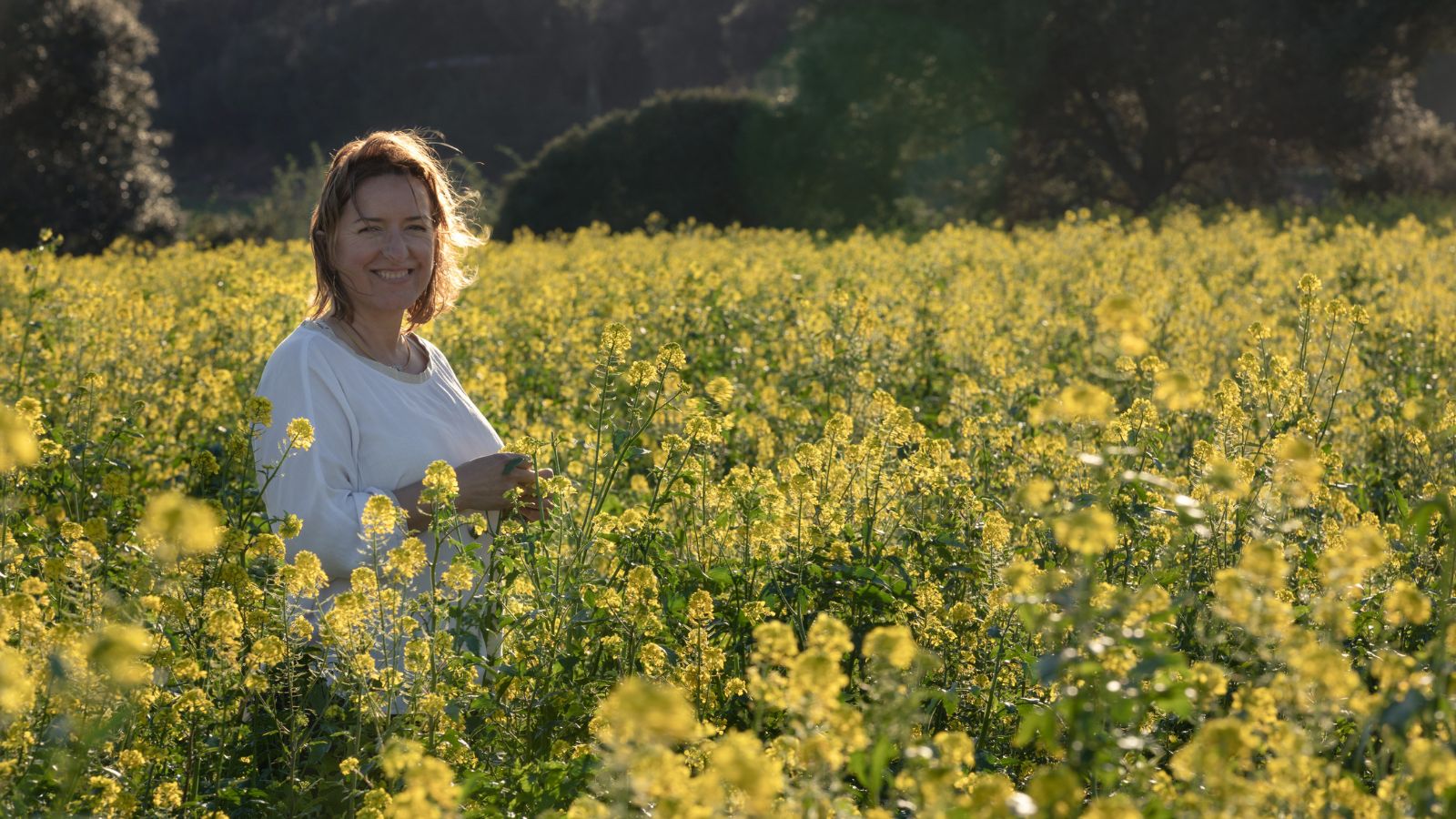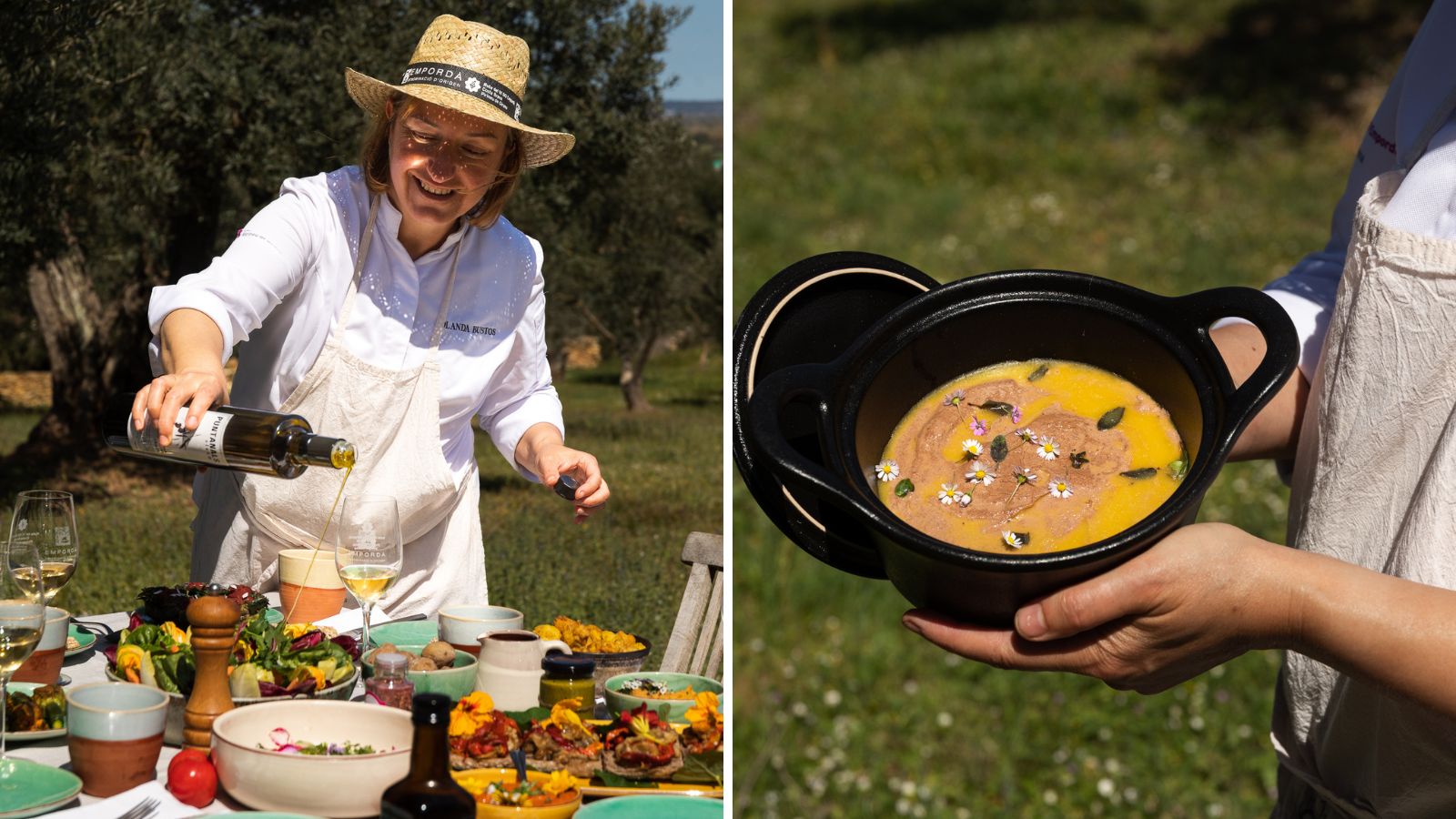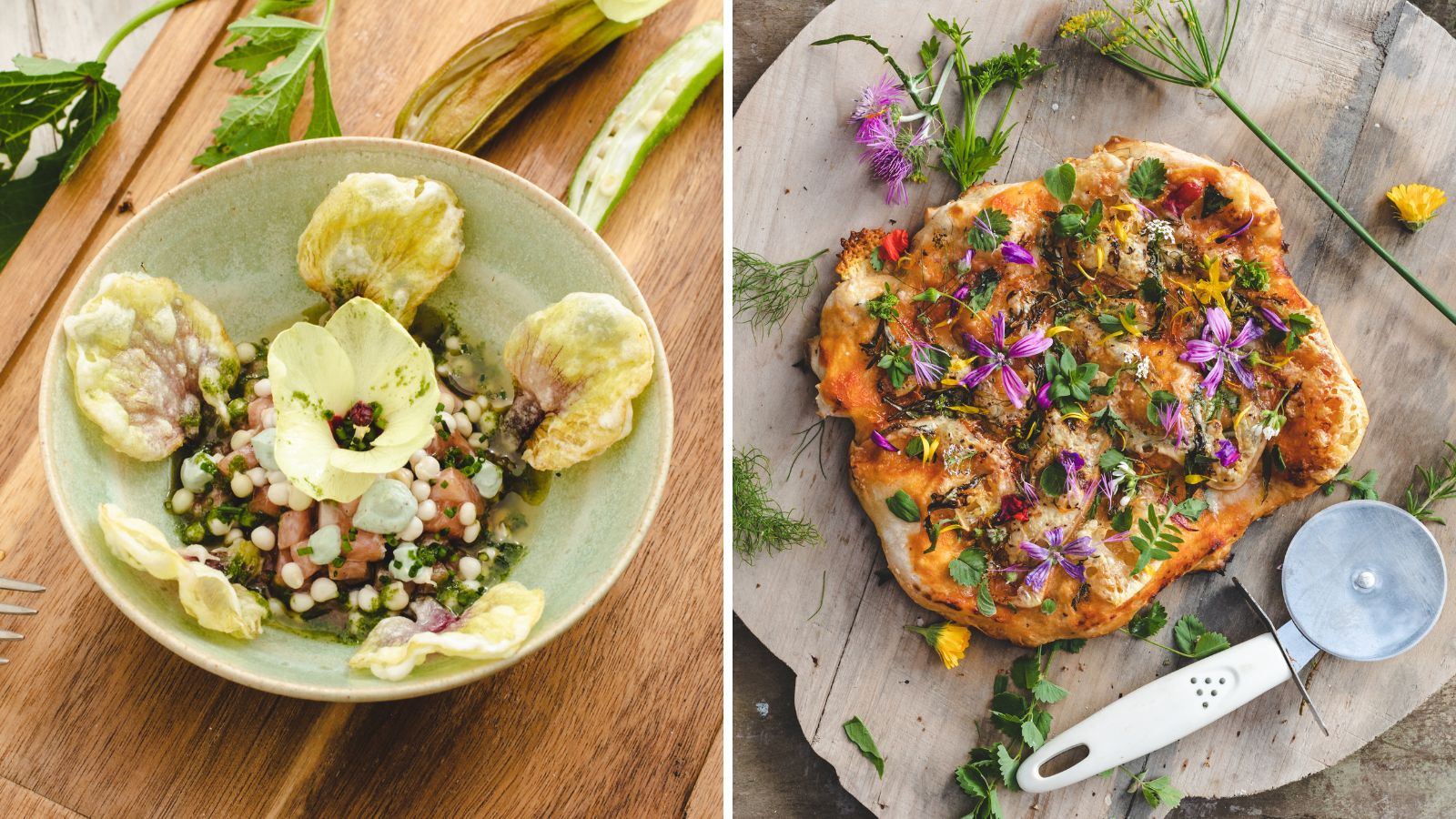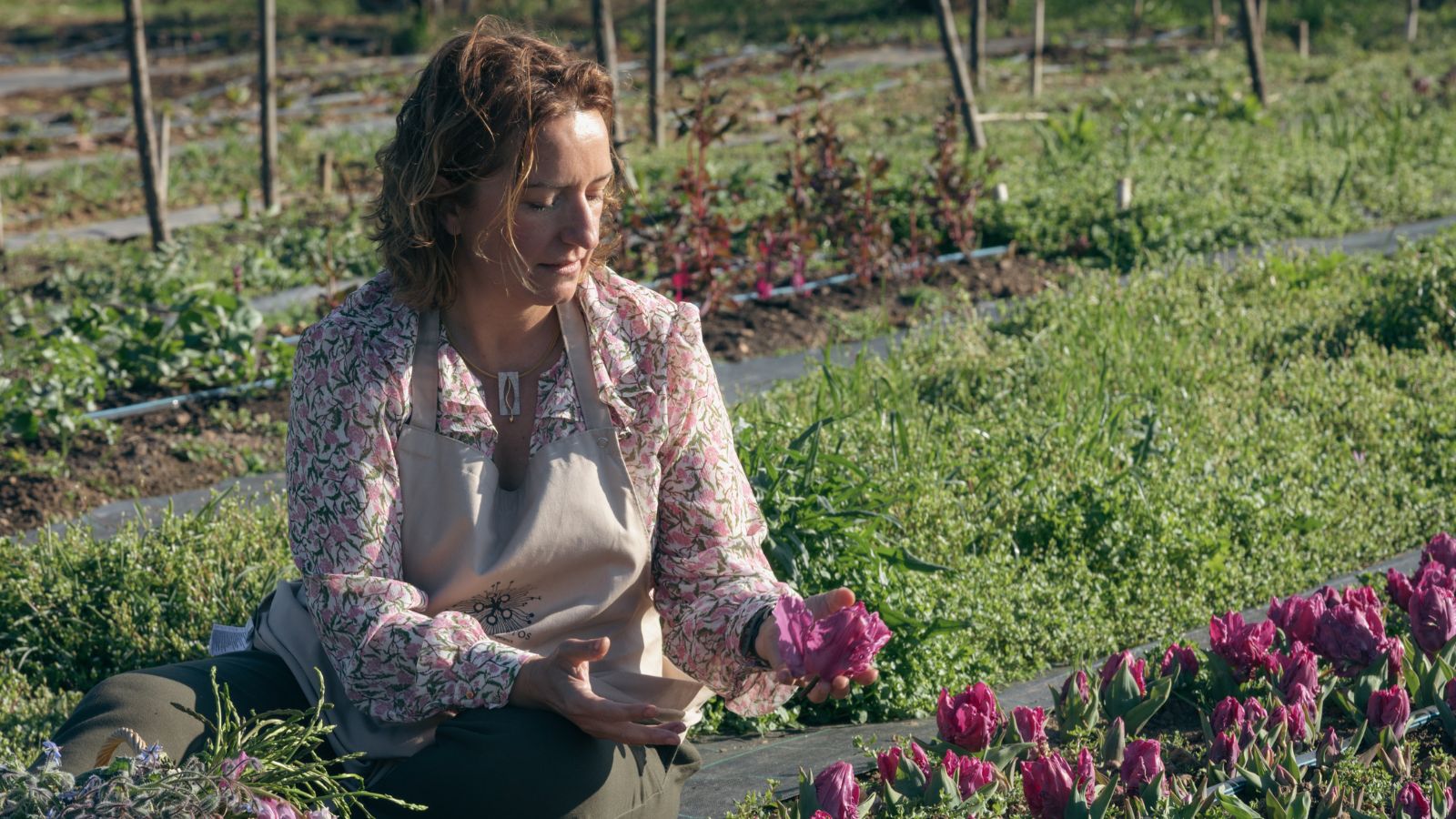They call her ‘cocina de flores,’ or ‘the chef of flowers.’ Spanish chef Iolanda Bustos has a vibrant, passionate appearance and a deep connection to the natural world. When creating recipes, she makes flowers the center of the dish. “I always start with the flower,” she shares. After Food Inspiration witnessed her live cooking demonstration at the Hospitality Fair in Malaga, we asked her to share some hands-on tips for cooking with flowers.
Bustos’ mission as a cook is to help people love nature through flavor. She also aims to raise awareness about how to utilize plants, and the importance of respecting them. In 2009, together with her husband, she launched her restaurant, La Caléndula in Girona, and created a leading role for flowers. Then in 2020, Bustos determined that she wanted more freedom to create. So she left the restaurant kitchen and began a variety of projects related to the countryside, flowers, and gastronomy.
Apart from cooking as a private chef and being a forager, Bustos also regularly teaches, lecturing at schools and presenting at gastronomic congresses. At the same time, she’s exploring, expanding, capturing, and preserving her knowledge of the use of plants in the kitchen. She has written multiple books (in Spanish) on cooking with flowers. Her latest research project will result in a new book on cooking with trees that is scheduled for release in 2025.

Delicate and ephemeral
In the last few years, foraging has been gaining in popularity, with baskets and dishes brimming with wild mushrooms, fresh fruits, and homegrown herbs adorning kitchens. Somehow, flowers continue to be overlooked. As Bustos explains, "Flowers present a delicate, ephemeral aspect. They are as tasty as mushrooms or herbs but require meticulous collection and preservation efforts. Picking flowers is a very precise and time consuming act. Flowers are so delicate that they need special treatment. When you take a flower from the field or forest, you can only keep it 'fresh' for two or three days maximum, depending on how you conserve it. That's very different from mushrooms or herbs, which are more forgiving and robust.”
"Flowers are delicate and ephemeral, mushrooms and fresh herbs are more forgiving and robust"
A form of culinary art
But there is more to it. “You can never fill a dish with only flowers,” Bustos continues. “It is an important part of the dish, but volume-wise very insignificant. To fully valorize the flower in a dish, a chef really has to put his or her intention into using it. Interpreting flowers, harmonizing them on the plate to accentuate their essence, requires culinary finesse. Cooking with flowers isn't just about garnishing; it's an art form."
Bustos' fascination with flowers dates back to her childhood. Her father was a farmer and a shepherd; her mother was a cook and had her own restaurant. As a child, she would accompany her father into the fields with his flock of sheep. Since then, she's been captivated by the concept of wild edibles – pure, untouched flavors that, in her opinion, evoke the essence of nature. "Chefs narrate their lives through recipes, and mine has been intertwined with flowers since childhood. If I were a painter, I'd paint them; if a singer, I'd compose songs about them."

HOW TO GUIDE
PUTTING FLOWERS ON THE PLATE
Start experimenting
"I always start with the flower. The recipe that follows is inspired by the structure and delicacy of each flower. Whether raw, cooked, dried, or frozen, each flower possesses unique characteristics. So it's all about experimenting. It depends on the flower, how you can best use it. And you will slowly discover the best techniques when you start practicing with cooking flowers. Trust the process. The flower will tell you how she likes to be cooked."
Preparation suggestions
-
Rice tempura-battered flowers. Simply mix rice flour and water, dip the flowers, and fry them in abundant olive oil until crisp. They make a delightful appetizer.
-
Flower omelettes. These will provide a feast for the eye.
-
Floral pestos. Try substituting basil with rose petals.
-
Meringues. Mix violets with your batter. The meringue takes on the color of the violet. Serve as a dessert, with fresh violets.
-
Syrups, vinegars, oil infusions. Use flowers to create spectacular flavors to deepen your dishes.
Floral mise en place
“In my kitchen this involves various stages. For fresh usage, flowers that can be preserved in jars with water, such as Borage, are collected every three days, with the most delicate gathered just before each service. Then there are floral preparations for beverages, sauces, or pantry recipes. These preparations adhere to the plant's life cycle and lunar cycles, ensuring maximum vitality and nutritional value. I follow biodynamic agricultural principles when harvesting and preparing.”
"Start with growing roses, tulips, wild mallows, elderflowers, daisies, and marigolds"
Entry-level flowers
“I always recommend starting with flowers that you can plant and grow in your own restaurant garden, because you know they're free of chemicals and grow in healthy conditions. Start with growing roses, tulips, wild mallows, elderflowers, daisies, and marigolds. There are many plants that grow well in vegetable gardens. You can also start with more rugged plants like brassica, cathaya, fedia, or wild mustard. These are very easy to recognize and give an interesting spicy tone to a variety of dishes.”
Store-bought versus wild
“Fortunately, the market offers an increasing variety of flowers, thanks to companies like Koppert Cress and local producers, such as Can Garús and Pámias Hortícolas in Spain. For restaurants, it's the most feasible and convenient option. Although caution is required due to the presence of toxic flowers, once you know which ones are edible, the energy of wild flowers surpasses that of cultivated ones sold in trays.”
Bustos’ personal favorites
-
Calendula: “This flower embodies my essence. It was the name I gave to my restaurant and it represents me botanically.”
-
Roses: “I adore roses for their myriad colors, flavors, and textures.”
-
Elderflower: “I create a delicious limited edition non-alcoholic sparkling ‘wine’ with it. Elderflower in general is an aromatic flower with versatile properties and gastronomic uses.”

"We humans are naturally drawn to the beauty and energy that flowers radiate"
The attractiveness of flowers
“For me, the flower always comes first when creating a recipe, with the flower being the leading character of the dish. Cooking with flowers is not just about aesthetics and flavor. Flowers are the plants’ powerhouse, and also deliver important nutritional and medicinal values. They provide antioxidants, specific types of amino acids, vitamins and minerals. But to me, the most fascinating thing about flowers is the emotion they evoke. The flower is the part of the plant that carries the most energy. It communicates with the surrounding fauna, tempting insects to pollinate. We humans are also fauna, so naturally we are drawn to the beauty and energy that flowers radiate. And that’s important when eating. When you are emotionally engaged, you forget about your worries. When you only concentrate on the food and the act of eating and enjoying it, your body starts to relax, or on the contrary gets aroused. You eat to feel good. The pleasure of eating - the emotional part - is as important as the nutritional part.”
The impact of terroir
“Botanic gastronomy is an evolving culinary field. We're increasingly learning about subsurface dynamics through wild plants' growth patterns. Flowers serve as bioindicators of ecosystem health. Furthermore, a plant's location influences the salinity, sweetness, intensity, and even the presence of wild yeasts in its flowers. For instance, the elderflowers I gather along the Costa Brava for my elderflower sparkling wine are more intense, with richer wild yeast content compared to those from the Pyrenees mountains. Mountainous regions receive more rainfall, carrying pollen, yeasts, and influencing flavors, aromas, and essential oil concentrations. So yes, terroir has a big impact.”

“In the build up of my menu, I start with the more bitter flowers to generate appetite, and I use more digestive plants towards the end of the meal"
The power of plants
"Since I was little, my mother has always incorporated flowers and other natural compounds into our family meals, depending on our needs. Plants and flowers provide us with an all natural medicine cabinet. Today, depending on the weather, the season or the mood, I adapt my menus accordingly. For me, it’s a very intuitive style of cooking.”
“In the build up of my menu, I start with the more bitter flowers to generate appetite, and I will use more digestive plants towards the end of the meal. My guests often comment, 'I ate quite a lot, but I don't feel full. I'm okay and I feel happy.' And the next day, they will say, 'I could relax and sleep well all night. My body had no trouble digesting. That never happens if I go out to a restaurant.' That is truly plant power.”